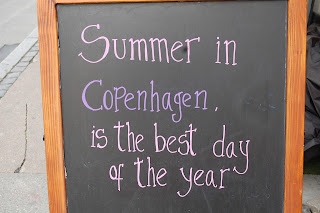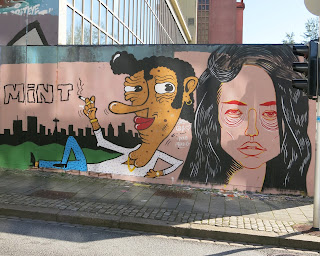We drove two and a half hours northeast to
Sassnitz, where we caught the ferry to
Trellborg, Sweden, and then on to
Malmo, where we had a hotel room in a brand-new area. The Art is already in place.
 |
| Ekvilibrist by Joep van Lieshout, 2011, in front of shopping mall. |
 |
| Mother by Charlotte Gyllenhammar, 2014. |
 |
| Malmo bridge to Copenhagen. |
We began by driving east to
Skane to see the
Ale's Stones of
Kåseberga. Estimates put the site, which is in the elliptical shape of a boat, at 1,400 years ago. The end of the Nordic Iron Age.
 |
| Stones are in center. |
 |
| Guarded by Sheep. |
On the way back to Malmo, we spotted a sign for a
Skulpturparken on the grounds of
Marsvinsholms Castle. An annual show, it turned out to be rather nice. Here are a few pieces:
 |
| Dansande flickor by Joze Strazar Kiuohara |
 |
| Galatea by Peter Mandl |
 |
| Sektorns mekanik by Bertil Herlow Svensson |
 |
| Philosopher surfing on a wave of future by Richard Brixel |
 |
| Guardians by Klas Sundkvist |
Back in Malmo, we took the train over the bridge to
Copenhagen. Just because we could.
We began the next day at the shore, where just behind the beach we found the
FEI European Championships for Ponies. We watched what looked like full-sized horses doing the usual routine of gaits, steps, and patterns.
There would be jumping later in the day, so we walked up the beach into town for a look around:
 |
| Kanotisten by Carl-Bertil Widell |
 |
| The Wave of the Baltic Sea by Gunnel Frieberg, 1983 |
 |
| Till Erinran by Axel Wallenberg, 1951 |
 |
| Pulserande koordinatsystem by Leif Bolter, 1967-70 |
The
Konsthalle was free, but offered nothing of interest to us, so we continued on to the
Modern Museet, which offered a very interesting exhibition of Art by Swedish artist
Nils Dardel. Influenced primarily by the
Fauves, Dardel developed a vivid palette and dramatic composition. He thought of himself as the
Dandy. In 1912 he met art dealer
Wilhelm Uhde who introduced him to
Henri Rousseau. A meeting that would have a lasting impact.
 |
| Self-portrait with hat by Nils Dardel, 1911 |
 |
| Exotic Landscape by Nils Dardel, 1918 |
 |
| The Shepherd and the Rats by Nils Dardel, 1922 |
 |
| The Dying Dandy by Nils Dardel, 1918 |
He didn't die until 1943, in NYC.
Then more Malmo.
 |
| Fiskegumma by Clarence Blum, 1949 |
 |
| Rubato by Eva Hild, 2015 |
 |
| Odd Fellow Palatset, 1904 |
Back at the horse show:
Driving up the Swedish coast, our next stop was
Gothenborg.
The main attraction here was the
Konst Musee.
 |
| Poseidon by Cark Milles, 1931 |
 |
| Tommy by Tony Cragg, 2015 |
Before we went into the museum, we spotted a statue over to one side:
 |
| Victor Hasselblad by Ulf Celen, 2006, based on a prototype by Eino Hanski |
Apparently camera pioneer Victor Hasselblad was a native son. With a variety of offerings, we had a great time here. Of note was the Fürstenberg Gallery with its murals by Carl Larsson and sculptures by Per Hasselberg.
 |
| Nackrosen (water lily) by Per Hasselberg, 1892, walls by Carl Larsson |
 |
| The Child by Fredrik Raddum, 2005. |
 |
| Seconds in Ectasy by Cajsa von Zeipel, 2010 |
There were young Swedes taught by Matisse:
 |
| Jules Pacsin by Isaac Grunewald, 1921 |
 |
| Figures on Beach by Sigrid Hjerten, 1917 (wife of Isaac Grunewald) |
A large French collection:
 |
| Landscape by Raoul Dufy, 1935 |
 |
| Portrait of a Woman by Marie Laurencin |
And out in the city...
 |
| Karin Bove by Peter Linde 1900-1941 |
 |
| Non Violence by Carl Fredrik Reutersward, 1997 |
Then on to
Oslo. Let's start with some random shots.
 |
| Fru Fortuna by Per Ung, 2005 |
 |
| Tigeren by Elena Engelsen, 2000 |
 |
| Osvald monument by Bjorn Gulliiksen |
 |
| Oscar Mathisen by Arne Durban, 1958 |
 |
| Respite designed & constructed by the students at Norwegian schools of architecture, 2015 |
 |
| 1903 vintage |
 |
| Fellowship by Nico Widerberg, 2015 |
 |
| The Traveler by Kurt Laurenz Metzler, 2001 |
 |
| Liten Selma by Oddmund Raudberget |
 |
| Gunnar Sonsteby - Freedom Fighter by Per Ung, 2013 |
Vigeland, the product of the sculptor
Gustav Vigeland, is the big draw in Oslo, and rightfully so. But it turns out he has a brother who was also an artist.
Emanuel Vigeland was a multi-talented man who had a successful career producing decorative paintings, frescoes, and stained glass for many of Oslo's churches. He built his own mausoleum at
Slemdal shaped like a windowless church. Inside the walls and ceiling are covered in a massive fresco entitled
Vita. Difficult to see as it is virtually black inside, but the eye manages to see after a while. Ten years after he died in 1948, the mausoleum was opened to the public.
Pictures were naturally prohibited, but here are a couple I found.
Vigeland, in Frogland Park, was not far away. Starting in 1924, Gustav Vigeland began a twenty-year journey of making sculptures for his great fountain. 212 bronze and granite statues. The monolith is comprised of 121 figures. Here are just a few.
Ekebergparken Sculpture Park, on the opposite side of town, is on a hill overlooking Oslo.
I couldn't find out much about the park, but there was lots of sculpture, including some name artists.
 |
| by Dyre Vaa 1930s |
 |
| Levitating Woman by Matt Johnson, 2012 |
 |
| Venus Victrix by Pierre-Auguste Renoir, 1914-16 |
 |
| Venus de milo aux tiroirs by Salvadore Dali |
Back in town, we went to the
National Gallery, which was free on Sundays, so there was a bit of a line. But lots of nice Art inside.
 |
| After the Bath by Auguste Renoir |
 |
| Mrs. Manet in the Conservatory by Edouard Manet, 1879 |
 |
| La Coiffure by Edgar Degas, c 1893 |
 |
| In the Skerries by Anders Zorn, 1894 |
 |
| Breakfast in Sora by Peder Severin Krøyer, 1880 |
There was one room in which I could not take pictures - the
Munch Room. Seventeen paintings including a version of
The Scream.
Once again, skipped the contemporary art museum. Stopped at the
Central Cafe to take pics of the murals there done by
Per Krohg, who did the mural overlooking the UN Security Council.
The
National Museum for Contemporary Art was also free, so we stopped in. Not a ton to like, but they did have a couple of names to offer.
 |
| Quarantania by Louise Bourgeois, 1847-53 |
 |
| Half-Off B by Sol LeWitt, 1980 |
The
Munch Museum was having a special exhibition pairing
Munch with
Van Gogh. The quality of those Van Goghs was remarkably high, featuring a Potato Eaters, Starry Night, Boats at Saintes Maries, and more. Of course, no photos. These are their self-portraits, for example:
Back in the center we walked all the way around the magnificent city hall. Begun in 1931 and interrupted by the war, it was not inaugurated until 1950. There are many lovely architectural details on the outside:
 |
| Per Palle Storm |
The
Nobel Peace Prize banquet takes place here each year.
 |
| Radhushallen (grand function room) |
 |
| by Henrik Sorensen |
 |
| by Alf Rolfsen |
Much of the interior was closed due to a special event, but Marie was able to get a glimpse of the Munch mural, entitled
Life, inside. One of the towers has a 49-bell carillon which chimes every 15 minutes as well as playing weekly concerts (apparently annoying some of the neighbors). Outside was a series of wooden artworks depicting Norwegian folklore adorning both sides of the courtyard/entrance by
Dagfin Werenskjold.
 |
| Embla (Elm) by Dagfin Werenskjold |
 |
| Swan Maidens by Dagfin Werenskjold |
 |
| Tor is Driven by his Goats by Dagfin Werenskjold |
Finally, a few more shots from around Oslo.
 |
| Leif Juster by Nina Sundbye |
 |
| Memorial to Johan Svendsen by Stinius Fredriksen, 1940 |
 |
| Jordmusikk by Harald Oredam, 1985 |
 |
| Heptakord by Turid Eng, 1984 |
 |
| She Lies by Monica Bonvicini, 2007 |
 |
| Ansikt by Kjersti Wexelsen Goksoyr, 1999 |
 |
| by Skule Waksvik, 1989 |
There was one final sculpture park for us to find at the end of the boardwalk in Oslo Harbor. The
Selvaag Collection at
Tjuvholmen consists of seven sculptures by international artists. We skipped the
Astrup Fearnly Museum, which was right there, as it was contemporary art that did not look appealing.
 |
| Untitled (Totem) by Ellsworth Kelly, 1998 |
 |
| Eyes by Louise Bourgeois, 1997 |
 |
| Edge II by Antony Gormley, 2000 |
Just a few more shots.
 |
| Dykkar by Ola Enstad (1943-2013), 2013 |
Appropriately, we took the
Oslofjordtunnel to get out of town. At 7239 meters long (4.554 miles) it is only the third longest subsea tunnel in Norway. Our trip north to
Flam was filled with all sorts of tunnels. Most were long, narrow, raw, unlined stone, with little-to-no light. Fortunately, the traffic was very light. Often a tunnel would lead right out to a bridge and then back into another tunnel on the other side. There were tunnels with hairpin turns inside and some with hairpin turns right outside the tunnel entrance. There could be a rotary right there when you come back to sunlight or rotaries inside the tunnels. Some tunnels spiraled upward or downward, often they just went straight up or down. It was fairly mind-boggling. There are over 900 tunnels in Norway.
But between the tunnels, the scenery was spectacular.
 |
| Flam |
At
Flam we wanted to continue on to Bergen but learned that the tunnel was closed due to a fire. We had to retrace part of our route before finding the road to Bergen.
And as far as Art was concerned. The pickings were slim.
Bergen is Norway's Second City and a popular stop for cruise ships. Fun to walk around.
 |
| Royal Norwegian Naval Forces Band |
We took the Fløibanen Funicular up to Mt. Fløyen for the views.
 |
| Propellen by Eva Karin Fremstad,2002 |
 |
| Fish carrier known as Ascension, 1870 mosaic |
 |
| Rod Vind by Arnold Haukeland, 1978 |
 |
| Dansk Pige by Gerhard Henning, 1955 |




































































































































































































